Key takeaways
- Activist teacher resources enhance traditional curricula by connecting subjects like coding to real-world social issues, promoting critical thinking and activism.
- Scratch coding fosters creativity and confidence, allowing students to visualize social issues through interactive stories and games.
- Breaking lessons into manageable parts and incorporating reflection deepens student engagement and strengthens their connection to activist themes.
- Student-led projects in Scratch, reflecting their interests, significantly boost motivation and make learning purposeful and impactful.

Understanding Activist Teacher Resources
Activist teacher resources, in my experience, go beyond traditional lesson plans—they are tools that empower educators to inspire critical thinking and social awareness in students. Have you ever felt the need to connect coding or any subject with real-world issues? These resources help bridge that gap, making learning purposeful and impactful.
I remember the first time I encountered activist teaching materials; it was like a breath of fresh air. They don’t just provide facts but challenge both teachers and students to question norms and consider their roles in society. Isn’t that what education should be about—sparking meaningful change, one classroom at a time?
Understanding these resources means recognizing their potential to transform standard curricula into dynamic conversations about justice, equity, and community engagement. They invite us, as educators, to reflect deeply on what we teach and why, turning every lesson into an opportunity for activism.
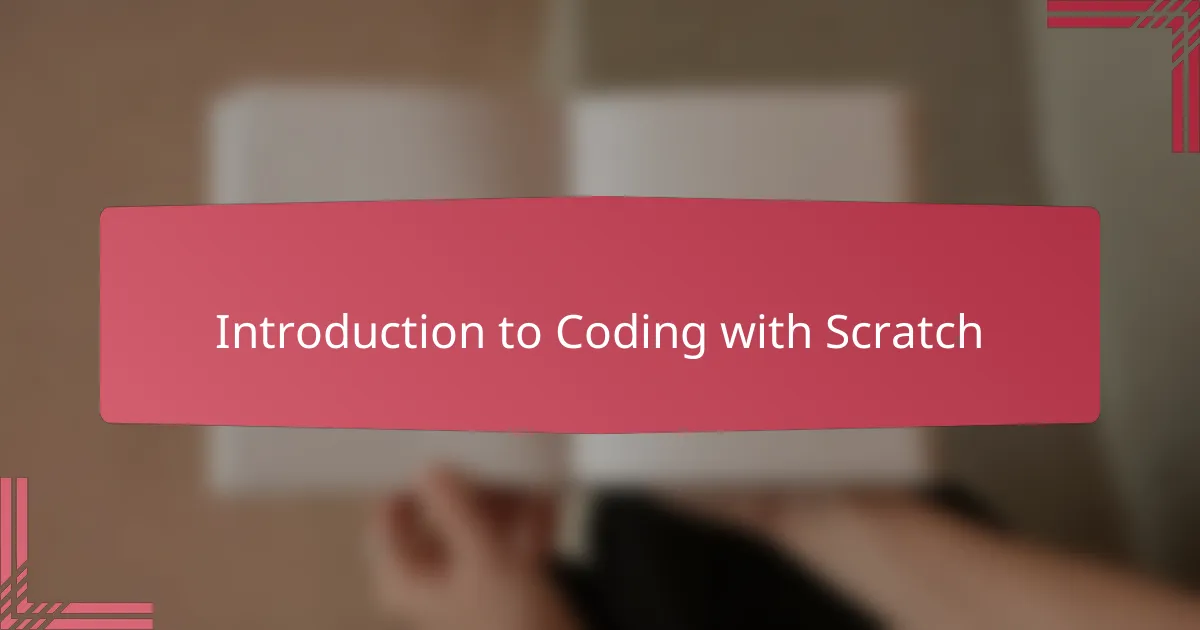
Introduction to Coding with Scratch
When I first discovered Scratch, it felt like unlocking a new language—one that spoke in colorful blocks instead of lines of text. Have you ever played around with Scratch? It’s surprisingly intuitive, making coding accessible even for those who might feel intimidated by traditional programming languages.
What I love about Scratch is how it invites creativity; you’re not just writing code, you’re telling stories, designing games, or animating ideas. It reminds me of the first time I watched a student’s face light up when their project came to life—there’s something truly magical in that moment.
Coding with Scratch isn’t just about technical skills; it’s about building confidence and problem-solving in a way that feels playful and engaging. Isn’t that the kind of learning experience every student deserves? From my experience, Scratch offers a perfect stepping stone into the world of coding.
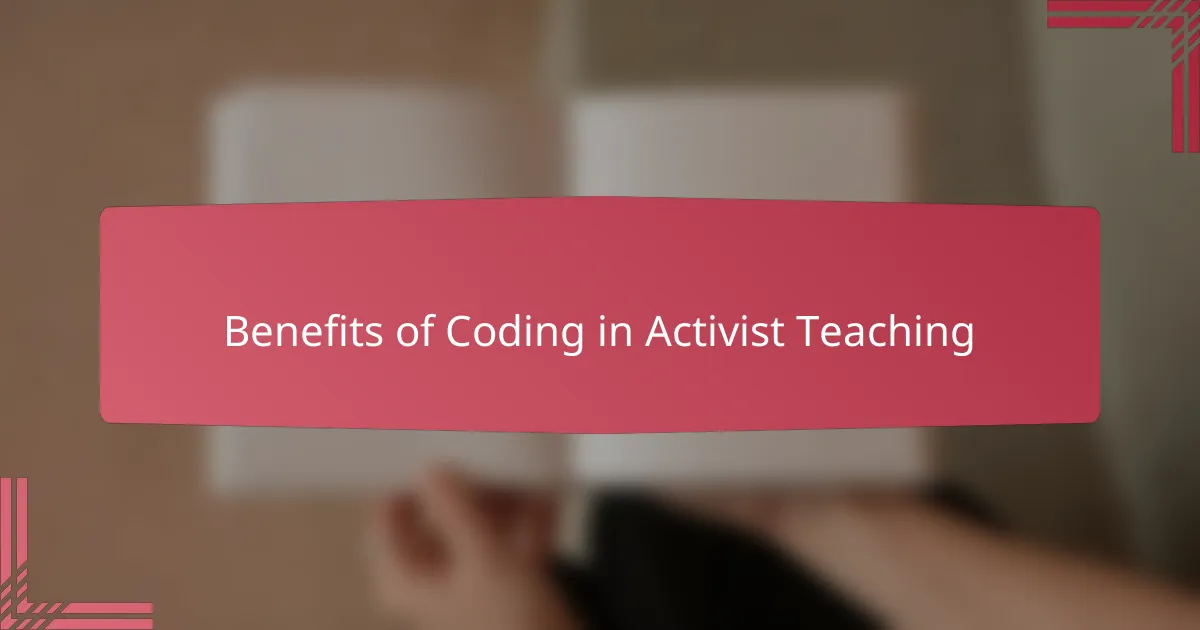
Benefits of Coding in Activist Teaching
Coding in activist teaching, as I’ve seen, opens doors for students to not just learn technology but to explore social issues creatively. Have you noticed how building a game or interactive story around a cause makes the message stick? I’ve found that when kids code their ideas about justice or equality, they take ownership of their learning and feel empowered to express their voices.
There’s something uniquely powerful about using Scratch to visualize problems that matter. I recall a project where students coded simulations about environmental impacts—it sparked discussions that textbooks alone never could. Coding becomes more than a skill; it transforms into a tool for critical thinking and activism, bridging technical understanding with real-world relevance.
Moreover, integrating coding with activist goals nurtures collaboration and empathy. When my students work together to design digital projects addressing community issues, they listen, reflect, and challenge each other’s perspectives. Isn’t that the very essence of active citizenship? This approach makes learning meaningful and cultivates a deeper connection between technology and social change.
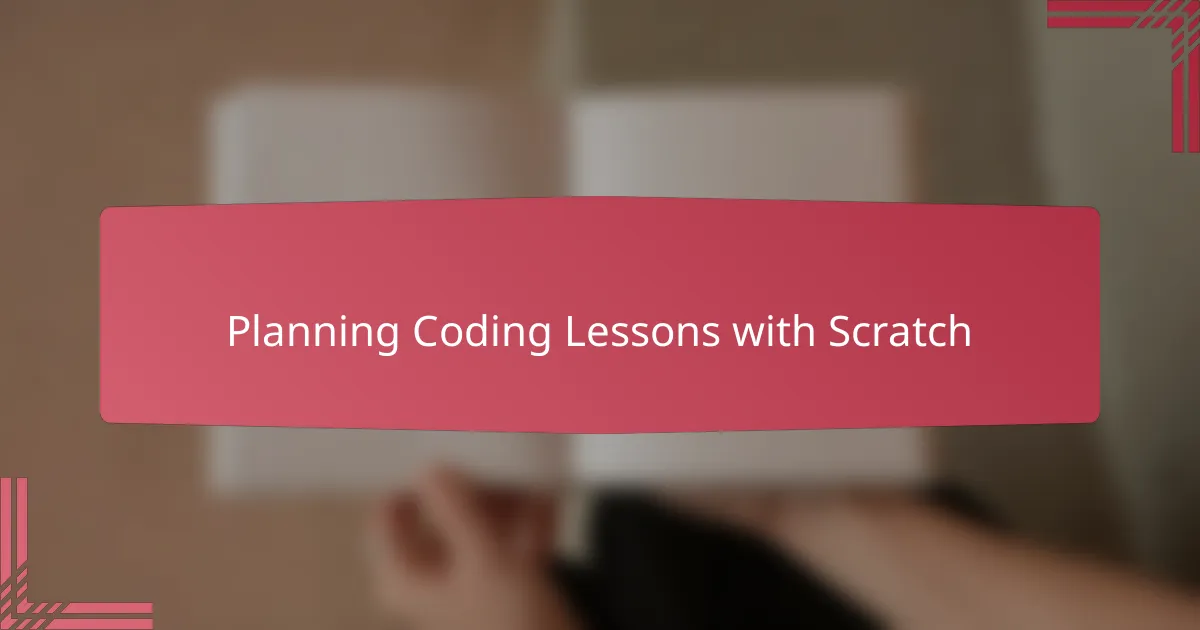
Planning Coding Lessons with Scratch
Planning coding lessons with Scratch always starts with a clear purpose for me. I ask myself: What social issues or activist themes do I want students to explore through their projects? This intentional focus guides how I frame challenges and select Scratch activities that feel both relevant and inspiring.
I’ve learned that breaking lessons into manageable chunks helps students build confidence step-by-step. For instance, I might begin with simple animations before moving to interactive stories that address real-world problems. When students see how each lesson connects to a bigger cause, their motivation skyrockets—have you experienced that energy in your classroom?
Sometimes, I map out checkpoints where students share ideas and reflect on how their coding choices express their values. Creating space for discussion alongside coding keeps the lessons grounded in activism and curiosity. It’s a delicate balance, but when it works, I watch students become thoughtful creators, not just code writers.
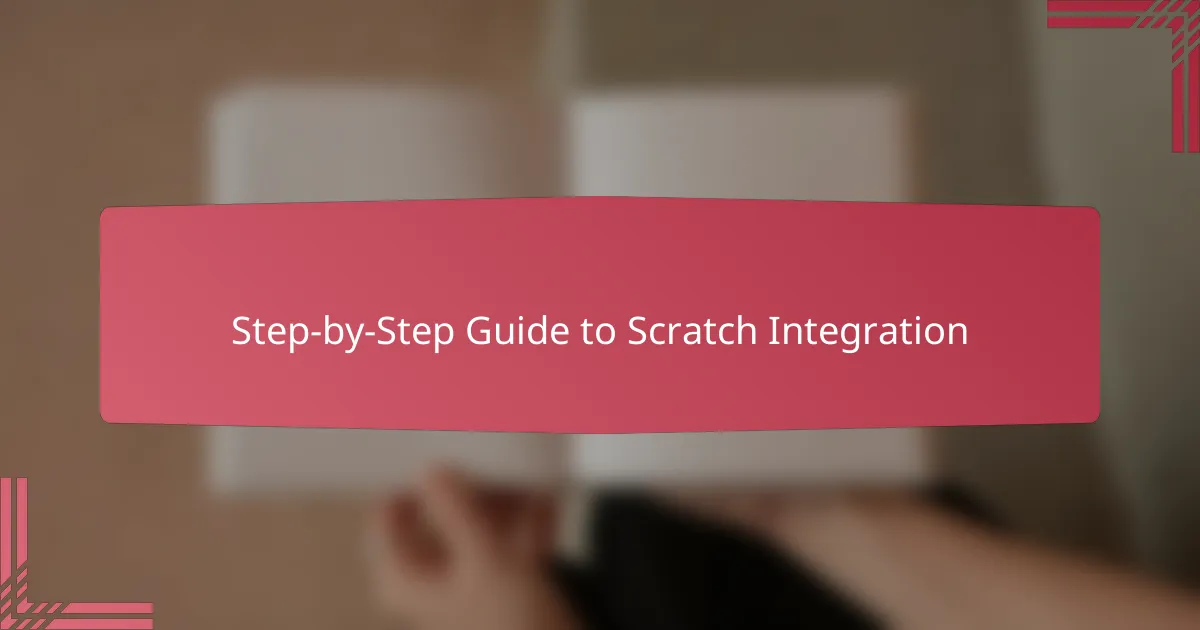
Step-by-Step Guide to Scratch Integration
Integrating Scratch into my activist teaching has been a rewarding process that I approach step-by-step. I start by introducing students to the basics: dragging and dropping code blocks to create simple sprites and animations. Have you noticed how even these small successes spark curiosity? From my experience, these early wins build the confidence needed to tackle more complex projects that carry a message.
Next, I guide students to design interactive stories or games that embed activist themes. For example, one year I watched a group create a game about climate change, carefully coding choices that show consequences for the environment. It was powerful how the stepwise progression—from coding movements to scripting dialogue—helped them understand both technology and the issue deeply.
Finally, I always carve out time for reflection and iteration. Students share their projects, explain their coding decisions, and discuss how their work connects to real-world activism. This ongoing dialogue enriches the learning process and reminds me why taking coding one step at a time is so important—it transforms coding from a technical skill into a meaningful form of expression. Have you tried breaking down Scratch lessons this way? I’ve found it makes all the difference.
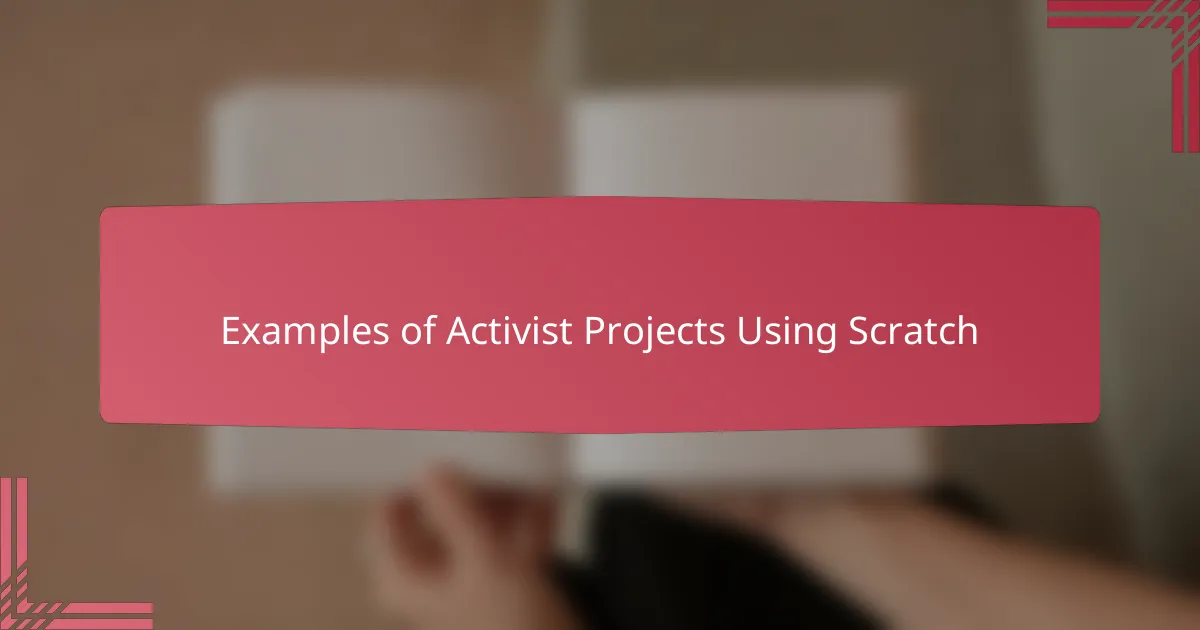
Examples of Activist Projects Using Scratch
One Scratch project that really stuck with me involved students creating an interactive story about refugee experiences. Watching them translate complex emotions and real-world challenges into code was eye-opening. Have you ever seen young coders use animation to foster empathy? I find that this approach brings activism to life in a way words alone often can’t.
Another memorable example was a game designed around food justice. The students coded scenarios that highlighted issues like food deserts and access disparities. It was inspiring to see how coding became their megaphone for raising awareness. Don’t you think giving students a platform to voice these concerns through technology makes activism more accessible and engaging?
I also recall a collaborative Scratch project focused on climate change solutions. Students programmed digital simulations of renewable energy sources, sparking lively debates about sustainability. What impressed me most was how they embraced both creativity and critical thinking, realizing that coding could be a powerful tool in their activist toolkit. Isn’t that the kind of learning that truly sticks?
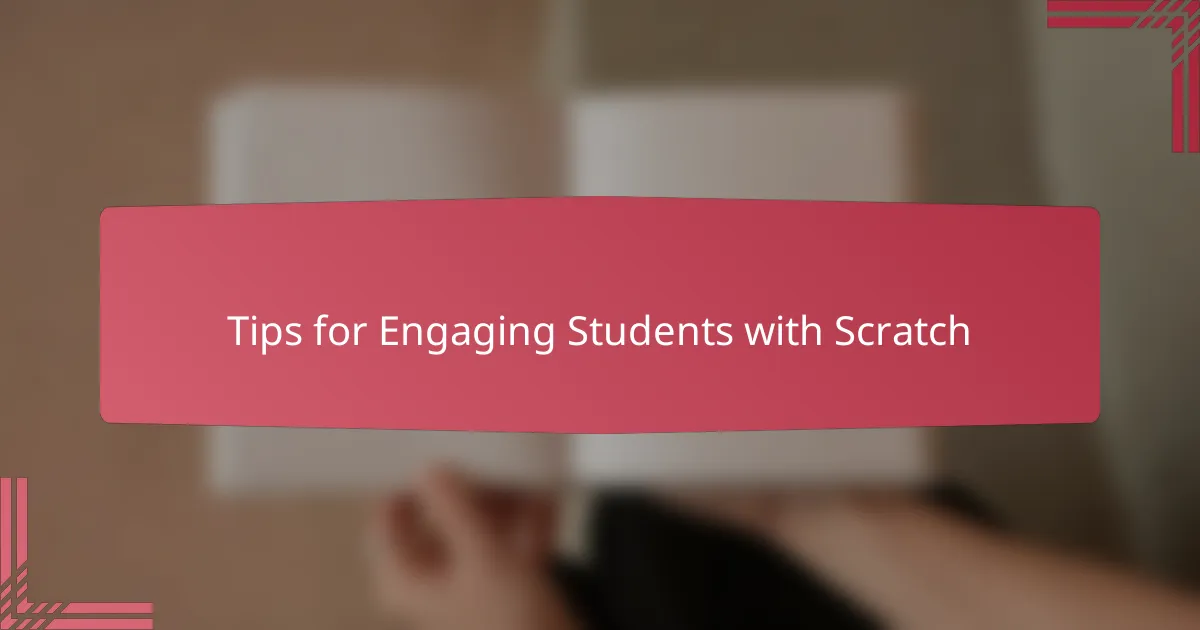
Tips for Engaging Students with Scratch
One thing I’ve noticed when engaging students with Scratch is to let them lead with their own ideas. When kids see their passions reflected in a project—whether it’s environmental justice or community stories—their excitement naturally grows. Have you ever tried stepping back and watching that spark ignite on its own? It’s a game-changer in keeping motivation high.
I also find it helpful to celebrate small victories along the way. Even a simple sprite moving across the screen can feel like a major achievement to a student just starting out. I remember a shy student bursting with pride after her first animation ran smoothly—it was a reminder that encouragement fuels more than just skills, it builds confidence and resilience too.
Finally, incorporating moments for reflection makes a big difference in engagement. Asking students why they made certain coding choices or how their project connects to social issues invites deeper thinking. Have you seen how this opens up new conversations and helps students see coding as a form of storytelling and activism? From my experience, it transforms Scratch from just a tool into a powerful means of expression.